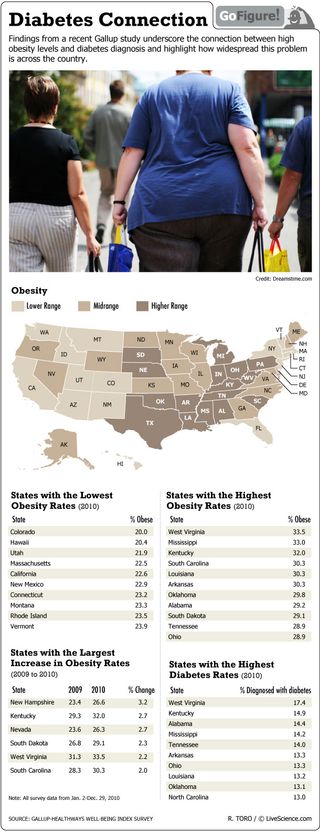Diabetes & Obesity in America (Infographic)

Being obese doesn't seem to have many upsides, with science finding evidence for its links to increased risks of heart disease, diabetes, depression and various other health problems.
Even people who are reportedly fat and fit — even though they are considered obese they are metabolically healthy — could improve healthwise from dropping a few pounds.
And perhaps where we live could impact whether we're doomed to an expanding waistline or a slim one. Results from a 2010 Gallup poll revealed the "fattest" and "skinniest" state based on interviews of 177,237 Americans, ages 18 and older, conducted January through June. Participants reported their height and weight, from which the researchers calculated body mass index. For this survey, BMI scores of 30 or higher were considered obese.
The survey revealed the nation's obesity rate has held steady from last year at 26 percent. It is slightly higher than the 2008 rate (25.5 percent). Even so, many of the country's most-obese states continue to see a trend in the wrong direction. For instance, last year about 27.6 of Delaware residents were obese; this year it's 33.6 percent. [US Loses Its Fat Supremacy]
The fattest states also seemed to be the ones with the highest diabetes rates. In fact, more recent research has shown there is a link between obesity and diabetes, with the "diabetes belt" also being home to more people who are obese (32.9 percent) than in the rest of the country (26.1 percent), and more people who don't exercise regularly (30.6 percent) than in the rest of the country (24.8 percent), according to the study published in the March 7, 2011, issue of the American Journal of Preventive Medicine.
The researchers found that nearly 12 percent of the people living in the diabetes belt -- counties in Alabama, Arkansas, Florida, Georgia, Kentucky, Louisiana, North Carolina, Ohio, Pennsylvania, South Carolina, Tennessee, Texas, Virginia and West Virginia, as well as the state of Mississippi -- have diabetes. That's compared with a national average of 8.5 percent, according to an article on MyHealthNewsDaily.
The main reasons for the prevalence of diabetes in this region are likely dietary habits, lack of physical activity and income level, said study researcher Lawrence E. Barker, of the CDC's Division of Diabetes Translation.
Sign up for the Live Science daily newsletter now
Get the world’s most fascinating discoveries delivered straight to your inbox.
